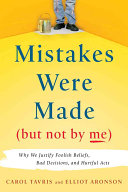
This was a truly eye-opening deep dive into cognitive dissonance theory and its by-product self-justification. Although I was generally familiar with the term ‘cognitive dissonance’ I had not been exposed to cognitive dissonance theory in any detail. Having read this book, the world we live in today and, in particular, the fact that so many people hold beliefs that seem completely contradictory to clear facts, is much more understandable. - Cognitive dissonance is a state of tension that occurs whenever a person holds two cognitions (ideas, attitudes, beliefs, opinions) that are psychologically inconsistent, such as “Smoking is a dumb thing to do because it could kill me” and “I smoke two packs a day.” - Dissonance produces mental discomfort, ranging from minor pangs to deep anguish; people don’t rest easy until they find a way to reduce it. - Self-justification is the usual mechanism by which people reduce dissonance. People become more certain about something they just did if they can’t undo it or if it came at some cost (time, money, effort etc). Information that is consonant with their belief / decision is accepted and conflicting information is considered biased. The first few chapters discuss the pyschology and scientific behaviour and how the brain and memory works. The rest of the book dives into specific examples of how self-justification manifests itself. The chapters on false memory and innocent people convicted of crimes are particularly powerful. A by-product of reading this book (at elast for me) is that it makes you examine your own deeply-held beliefs and look for evidence of self-justification. The challenge is that we are often blind to the lies we tell and have told ourselves so that self-justification may be very difficult to perceive.